Business Law 11 Assignment: Contract Formation, Offer, and Acceptance
VerifiedAdded on 2022/08/20
|12
|3206
|16
Homework Assignment
AI Summary
This business law assignment addresses key aspects of contract law, including the development of common law and equity, the elements of offer and acceptance, and the application of the postal rule. It analyzes the essential components for contract formation, emphasizing the significance of offer and acceptance, supported by relevant case law such as Adam v Lindsell and Henthorn v Fraser. The assignment further explores the concept of consideration, including the doctrine of promissory estoppel, as highlighted in the High Trees case, and its implications for part payment of debts. The assignment then examines the formation of contracts in specific scenarios involving the sale of goods, differentiating between offers and invitations to treat, with reference to cases such as Fisher v Bell and RTS Flexible Systems Limited v Molkerei Alois Müller GmbH. Finally, it identifies the essential elements, beyond offer and acceptance, required for a contract to be legally binding, emphasizing the role of consideration and the intention to create legal relations, as demonstrated in cases like Thomas v Thomas and Blue v Ashley.

Running head: BUSINESS LAW
BUSINESS LAW
Name of the Student
Name of the University
Author Note
BUSINESS LAW
Name of the Student
Name of the University
Author Note
Paraphrase This Document
Need a fresh take? Get an instant paraphrase of this document with our AI Paraphraser
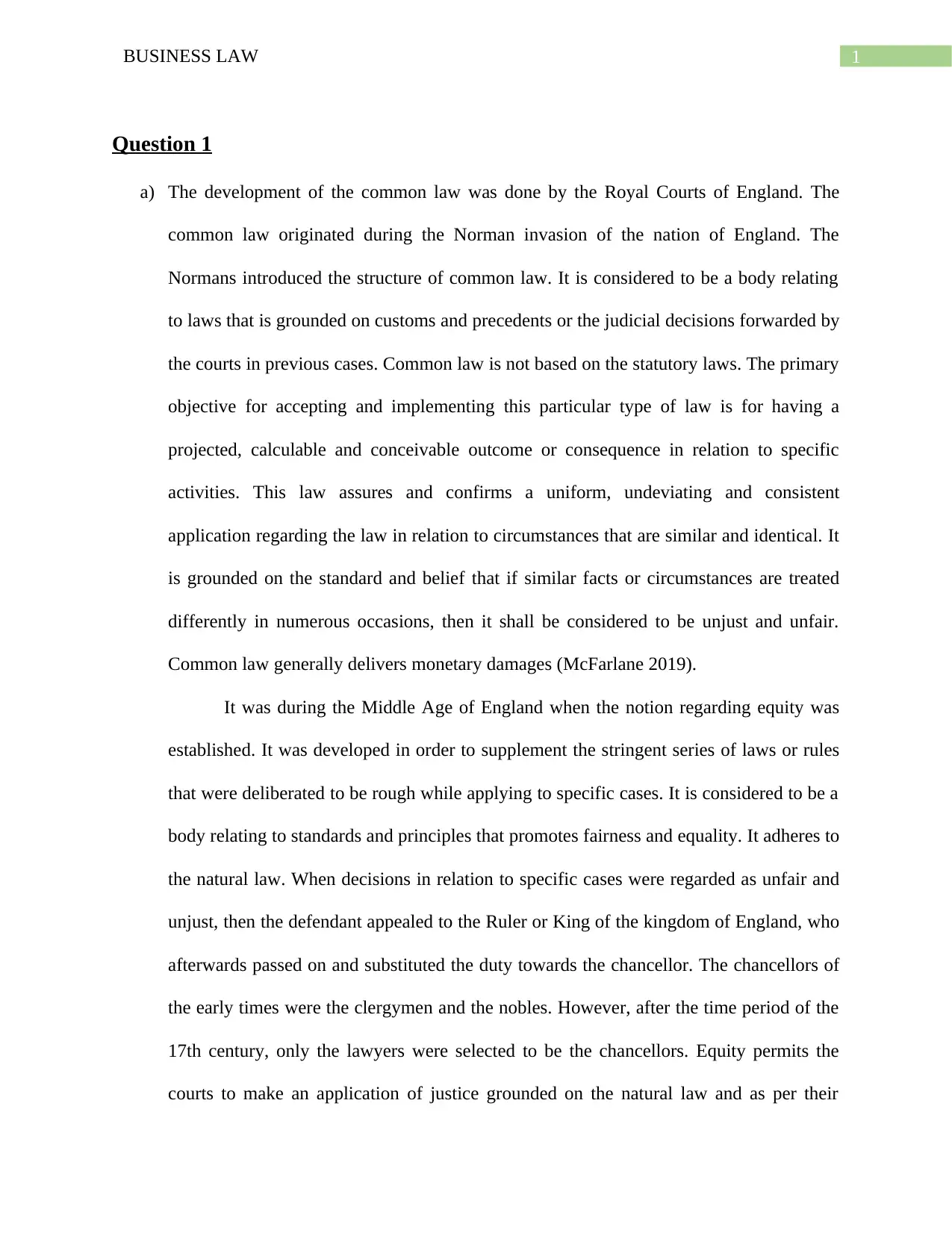
1BUSINESS LAW
Question 1
a) The development of the common law was done by the Royal Courts of England. The
common law originated during the Norman invasion of the nation of England. The
Normans introduced the structure of common law. It is considered to be a body relating
to laws that is grounded on customs and precedents or the judicial decisions forwarded by
the courts in previous cases. Common law is not based on the statutory laws. The primary
objective for accepting and implementing this particular type of law is for having a
projected, calculable and conceivable outcome or consequence in relation to specific
activities. This law assures and confirms a uniform, undeviating and consistent
application regarding the law in relation to circumstances that are similar and identical. It
is grounded on the standard and belief that if similar facts or circumstances are treated
differently in numerous occasions, then it shall be considered to be unjust and unfair.
Common law generally delivers monetary damages (McFarlane 2019).
It was during the Middle Age of England when the notion regarding equity was
established. It was developed in order to supplement the stringent series of laws or rules
that were deliberated to be rough while applying to specific cases. It is considered to be a
body relating to standards and principles that promotes fairness and equality. It adheres to
the natural law. When decisions in relation to specific cases were regarded as unfair and
unjust, then the defendant appealed to the Ruler or King of the kingdom of England, who
afterwards passed on and substituted the duty towards the chancellor. The chancellors of
the early times were the clergymen and the nobles. However, after the time period of the
17th century, only the lawyers were selected to be the chancellors. Equity permits the
courts to make an application of justice grounded on the natural law and as per their
Question 1
a) The development of the common law was done by the Royal Courts of England. The
common law originated during the Norman invasion of the nation of England. The
Normans introduced the structure of common law. It is considered to be a body relating
to laws that is grounded on customs and precedents or the judicial decisions forwarded by
the courts in previous cases. Common law is not based on the statutory laws. The primary
objective for accepting and implementing this particular type of law is for having a
projected, calculable and conceivable outcome or consequence in relation to specific
activities. This law assures and confirms a uniform, undeviating and consistent
application regarding the law in relation to circumstances that are similar and identical. It
is grounded on the standard and belief that if similar facts or circumstances are treated
differently in numerous occasions, then it shall be considered to be unjust and unfair.
Common law generally delivers monetary damages (McFarlane 2019).
It was during the Middle Age of England when the notion regarding equity was
established. It was developed in order to supplement the stringent series of laws or rules
that were deliberated to be rough while applying to specific cases. It is considered to be a
body relating to standards and principles that promotes fairness and equality. It adheres to
the natural law. When decisions in relation to specific cases were regarded as unfair and
unjust, then the defendant appealed to the Ruler or King of the kingdom of England, who
afterwards passed on and substituted the duty towards the chancellor. The chancellors of
the early times were the clergymen and the nobles. However, after the time period of the
17th century, only the lawyers were selected to be the chancellors. Equity permits the
courts to make an application of justice grounded on the natural law and as per their
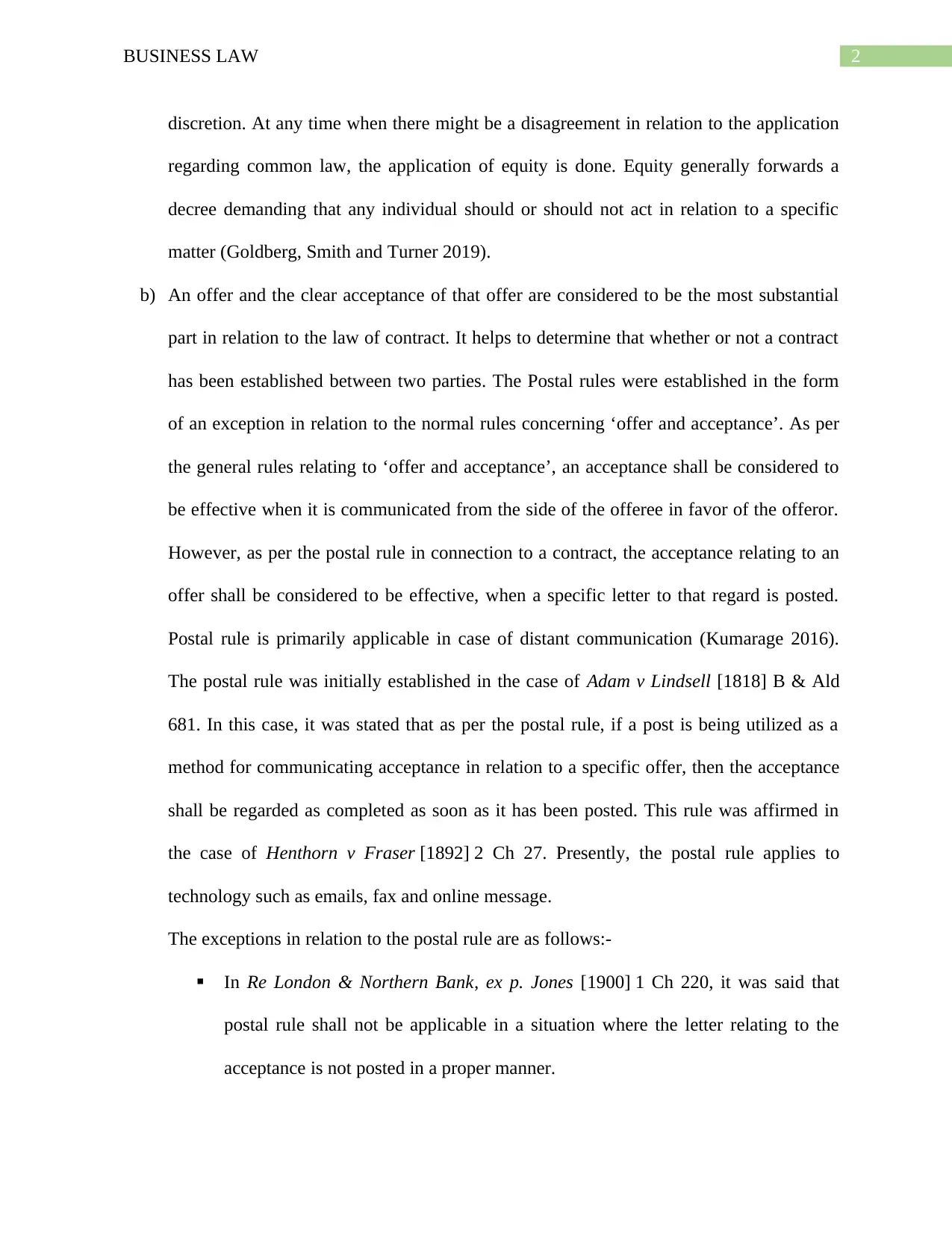
2BUSINESS LAW
discretion. At any time when there might be a disagreement in relation to the application
regarding common law, the application of equity is done. Equity generally forwards a
decree demanding that any individual should or should not act in relation to a specific
matter (Goldberg, Smith and Turner 2019).
b) An offer and the clear acceptance of that offer are considered to be the most substantial
part in relation to the law of contract. It helps to determine that whether or not a contract
has been established between two parties. The Postal rules were established in the form
of an exception in relation to the normal rules concerning ‘offer and acceptance’. As per
the general rules relating to ‘offer and acceptance’, an acceptance shall be considered to
be effective when it is communicated from the side of the offeree in favor of the offeror.
However, as per the postal rule in connection to a contract, the acceptance relating to an
offer shall be considered to be effective, when a specific letter to that regard is posted.
Postal rule is primarily applicable in case of distant communication (Kumarage 2016).
The postal rule was initially established in the case of Adam v Lindsell [1818] B & Ald
681. In this case, it was stated that as per the postal rule, if a post is being utilized as a
method for communicating acceptance in relation to a specific offer, then the acceptance
shall be regarded as completed as soon as it has been posted. This rule was affirmed in
the case of Henthorn v Fraser [1892] 2 Ch 27. Presently, the postal rule applies to
technology such as emails, fax and online message.
The exceptions in relation to the postal rule are as follows:-
In Re London & Northern Bank, ex p. Jones [1900] 1 Ch 220, it was said that
postal rule shall not be applicable in a situation where the letter relating to the
acceptance is not posted in a proper manner.
discretion. At any time when there might be a disagreement in relation to the application
regarding common law, the application of equity is done. Equity generally forwards a
decree demanding that any individual should or should not act in relation to a specific
matter (Goldberg, Smith and Turner 2019).
b) An offer and the clear acceptance of that offer are considered to be the most substantial
part in relation to the law of contract. It helps to determine that whether or not a contract
has been established between two parties. The Postal rules were established in the form
of an exception in relation to the normal rules concerning ‘offer and acceptance’. As per
the general rules relating to ‘offer and acceptance’, an acceptance shall be considered to
be effective when it is communicated from the side of the offeree in favor of the offeror.
However, as per the postal rule in connection to a contract, the acceptance relating to an
offer shall be considered to be effective, when a specific letter to that regard is posted.
Postal rule is primarily applicable in case of distant communication (Kumarage 2016).
The postal rule was initially established in the case of Adam v Lindsell [1818] B & Ald
681. In this case, it was stated that as per the postal rule, if a post is being utilized as a
method for communicating acceptance in relation to a specific offer, then the acceptance
shall be regarded as completed as soon as it has been posted. This rule was affirmed in
the case of Henthorn v Fraser [1892] 2 Ch 27. Presently, the postal rule applies to
technology such as emails, fax and online message.
The exceptions in relation to the postal rule are as follows:-
In Re London & Northern Bank, ex p. Jones [1900] 1 Ch 220, it was said that
postal rule shall not be applicable in a situation where the letter relating to the
acceptance is not posted in a proper manner.
⊘ This is a preview!⊘
Do you want full access?
Subscribe today to unlock all pages.

Trusted by 1+ million students worldwide
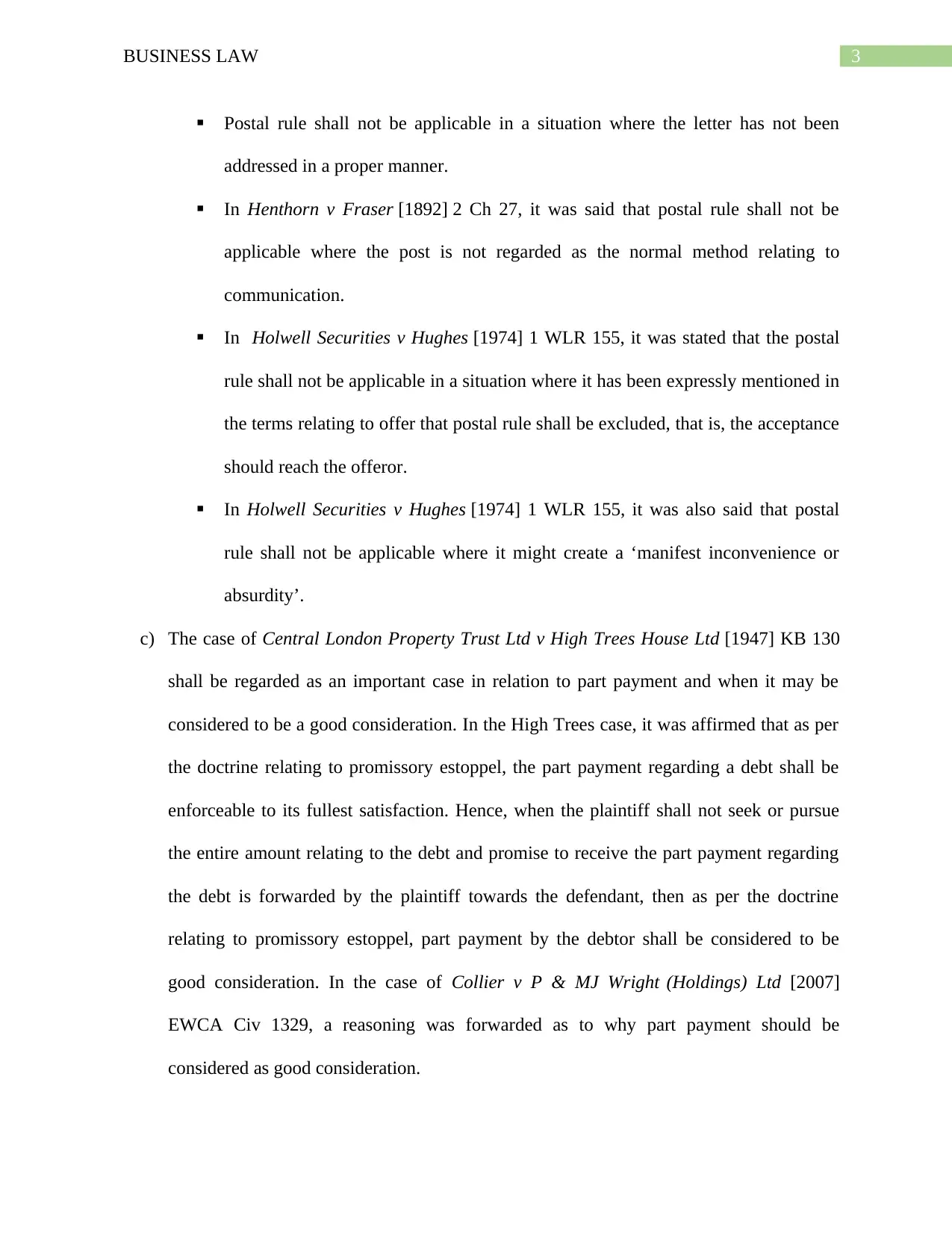
3BUSINESS LAW
Postal rule shall not be applicable in a situation where the letter has not been
addressed in a proper manner.
In Henthorn v Fraser [1892] 2 Ch 27, it was said that postal rule shall not be
applicable where the post is not regarded as the normal method relating to
communication.
In Holwell Securities v Hughes [1974] 1 WLR 155, it was stated that the postal
rule shall not be applicable in a situation where it has been expressly mentioned in
the terms relating to offer that postal rule shall be excluded, that is, the acceptance
should reach the offeror.
In Holwell Securities v Hughes [1974] 1 WLR 155, it was also said that postal
rule shall not be applicable where it might create a ‘manifest inconvenience or
absurdity’.
c) The case of Central London Property Trust Ltd v High Trees House Ltd [1947] KB 130
shall be regarded as an important case in relation to part payment and when it may be
considered to be a good consideration. In the High Trees case, it was affirmed that as per
the doctrine relating to promissory estoppel, the part payment regarding a debt shall be
enforceable to its fullest satisfaction. Hence, when the plaintiff shall not seek or pursue
the entire amount relating to the debt and promise to receive the part payment regarding
the debt is forwarded by the plaintiff towards the defendant, then as per the doctrine
relating to promissory estoppel, part payment by the debtor shall be considered to be
good consideration. In the case of Collier v P & MJ Wright (Holdings) Ltd [2007]
EWCA Civ 1329, a reasoning was forwarded as to why part payment should be
considered as good consideration.
Postal rule shall not be applicable in a situation where the letter has not been
addressed in a proper manner.
In Henthorn v Fraser [1892] 2 Ch 27, it was said that postal rule shall not be
applicable where the post is not regarded as the normal method relating to
communication.
In Holwell Securities v Hughes [1974] 1 WLR 155, it was stated that the postal
rule shall not be applicable in a situation where it has been expressly mentioned in
the terms relating to offer that postal rule shall be excluded, that is, the acceptance
should reach the offeror.
In Holwell Securities v Hughes [1974] 1 WLR 155, it was also said that postal
rule shall not be applicable where it might create a ‘manifest inconvenience or
absurdity’.
c) The case of Central London Property Trust Ltd v High Trees House Ltd [1947] KB 130
shall be regarded as an important case in relation to part payment and when it may be
considered to be a good consideration. In the High Trees case, it was affirmed that as per
the doctrine relating to promissory estoppel, the part payment regarding a debt shall be
enforceable to its fullest satisfaction. Hence, when the plaintiff shall not seek or pursue
the entire amount relating to the debt and promise to receive the part payment regarding
the debt is forwarded by the plaintiff towards the defendant, then as per the doctrine
relating to promissory estoppel, part payment by the debtor shall be considered to be
good consideration. In the case of Collier v P & MJ Wright (Holdings) Ltd [2007]
EWCA Civ 1329, a reasoning was forwarded as to why part payment should be
considered as good consideration.
Paraphrase This Document
Need a fresh take? Get an instant paraphrase of this document with our AI Paraphraser
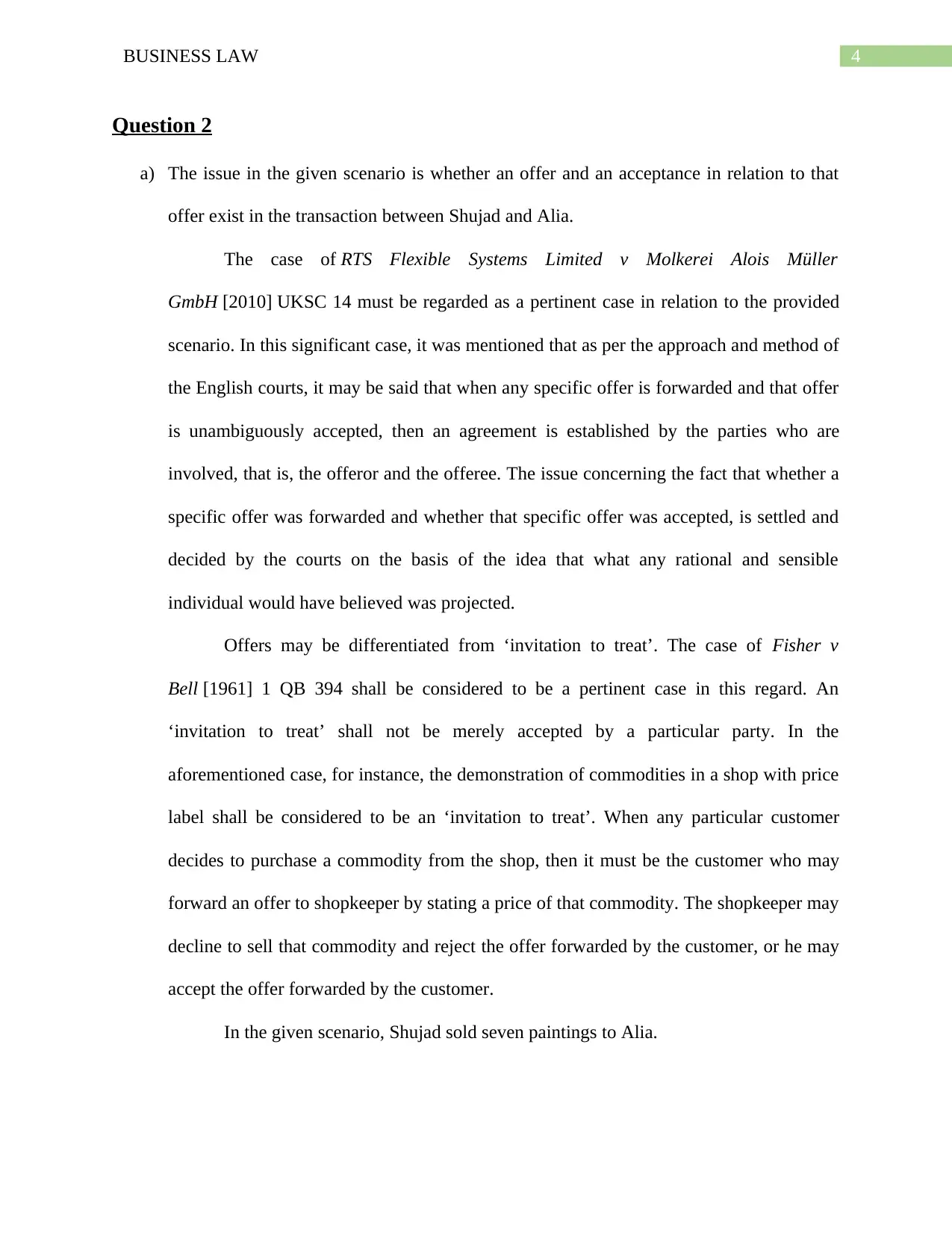
4BUSINESS LAW
Question 2
a) The issue in the given scenario is whether an offer and an acceptance in relation to that
offer exist in the transaction between Shujad and Alia.
The case of RTS Flexible Systems Limited v Molkerei Alois Müller
GmbH [2010] UKSC 14 must be regarded as a pertinent case in relation to the provided
scenario. In this significant case, it was mentioned that as per the approach and method of
the English courts, it may be said that when any specific offer is forwarded and that offer
is unambiguously accepted, then an agreement is established by the parties who are
involved, that is, the offeror and the offeree. The issue concerning the fact that whether a
specific offer was forwarded and whether that specific offer was accepted, is settled and
decided by the courts on the basis of the idea that what any rational and sensible
individual would have believed was projected.
Offers may be differentiated from ‘invitation to treat’. The case of Fisher v
Bell [1961] 1 QB 394 shall be considered to be a pertinent case in this regard. An
‘invitation to treat’ shall not be merely accepted by a particular party. In the
aforementioned case, for instance, the demonstration of commodities in a shop with price
label shall be considered to be an ‘invitation to treat’. When any particular customer
decides to purchase a commodity from the shop, then it must be the customer who may
forward an offer to shopkeeper by stating a price of that commodity. The shopkeeper may
decline to sell that commodity and reject the offer forwarded by the customer, or he may
accept the offer forwarded by the customer.
In the given scenario, Shujad sold seven paintings to Alia.
Question 2
a) The issue in the given scenario is whether an offer and an acceptance in relation to that
offer exist in the transaction between Shujad and Alia.
The case of RTS Flexible Systems Limited v Molkerei Alois Müller
GmbH [2010] UKSC 14 must be regarded as a pertinent case in relation to the provided
scenario. In this significant case, it was mentioned that as per the approach and method of
the English courts, it may be said that when any specific offer is forwarded and that offer
is unambiguously accepted, then an agreement is established by the parties who are
involved, that is, the offeror and the offeree. The issue concerning the fact that whether a
specific offer was forwarded and whether that specific offer was accepted, is settled and
decided by the courts on the basis of the idea that what any rational and sensible
individual would have believed was projected.
Offers may be differentiated from ‘invitation to treat’. The case of Fisher v
Bell [1961] 1 QB 394 shall be considered to be a pertinent case in this regard. An
‘invitation to treat’ shall not be merely accepted by a particular party. In the
aforementioned case, for instance, the demonstration of commodities in a shop with price
label shall be considered to be an ‘invitation to treat’. When any particular customer
decides to purchase a commodity from the shop, then it must be the customer who may
forward an offer to shopkeeper by stating a price of that commodity. The shopkeeper may
decline to sell that commodity and reject the offer forwarded by the customer, or he may
accept the offer forwarded by the customer.
In the given scenario, Shujad sold seven paintings to Alia.
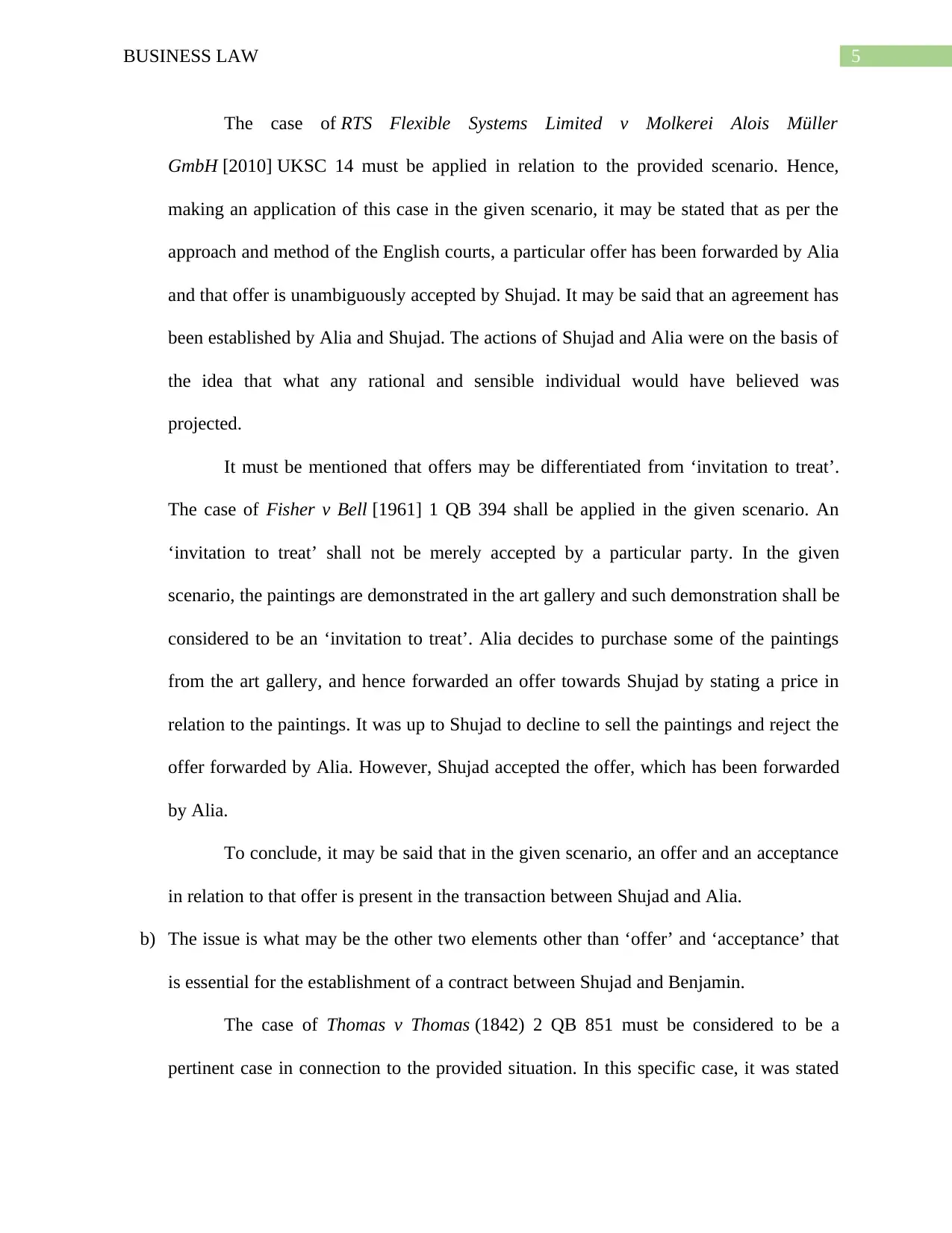
5BUSINESS LAW
The case of RTS Flexible Systems Limited v Molkerei Alois Müller
GmbH [2010] UKSC 14 must be applied in relation to the provided scenario. Hence,
making an application of this case in the given scenario, it may be stated that as per the
approach and method of the English courts, a particular offer has been forwarded by Alia
and that offer is unambiguously accepted by Shujad. It may be said that an agreement has
been established by Alia and Shujad. The actions of Shujad and Alia were on the basis of
the idea that what any rational and sensible individual would have believed was
projected.
It must be mentioned that offers may be differentiated from ‘invitation to treat’.
The case of Fisher v Bell [1961] 1 QB 394 shall be applied in the given scenario. An
‘invitation to treat’ shall not be merely accepted by a particular party. In the given
scenario, the paintings are demonstrated in the art gallery and such demonstration shall be
considered to be an ‘invitation to treat’. Alia decides to purchase some of the paintings
from the art gallery, and hence forwarded an offer towards Shujad by stating a price in
relation to the paintings. It was up to Shujad to decline to sell the paintings and reject the
offer forwarded by Alia. However, Shujad accepted the offer, which has been forwarded
by Alia.
To conclude, it may be said that in the given scenario, an offer and an acceptance
in relation to that offer is present in the transaction between Shujad and Alia.
b) The issue is what may be the other two elements other than ‘offer’ and ‘acceptance’ that
is essential for the establishment of a contract between Shujad and Benjamin.
The case of Thomas v Thomas (1842) 2 QB 851 must be considered to be a
pertinent case in connection to the provided situation. In this specific case, it was stated
The case of RTS Flexible Systems Limited v Molkerei Alois Müller
GmbH [2010] UKSC 14 must be applied in relation to the provided scenario. Hence,
making an application of this case in the given scenario, it may be stated that as per the
approach and method of the English courts, a particular offer has been forwarded by Alia
and that offer is unambiguously accepted by Shujad. It may be said that an agreement has
been established by Alia and Shujad. The actions of Shujad and Alia were on the basis of
the idea that what any rational and sensible individual would have believed was
projected.
It must be mentioned that offers may be differentiated from ‘invitation to treat’.
The case of Fisher v Bell [1961] 1 QB 394 shall be applied in the given scenario. An
‘invitation to treat’ shall not be merely accepted by a particular party. In the given
scenario, the paintings are demonstrated in the art gallery and such demonstration shall be
considered to be an ‘invitation to treat’. Alia decides to purchase some of the paintings
from the art gallery, and hence forwarded an offer towards Shujad by stating a price in
relation to the paintings. It was up to Shujad to decline to sell the paintings and reject the
offer forwarded by Alia. However, Shujad accepted the offer, which has been forwarded
by Alia.
To conclude, it may be said that in the given scenario, an offer and an acceptance
in relation to that offer is present in the transaction between Shujad and Alia.
b) The issue is what may be the other two elements other than ‘offer’ and ‘acceptance’ that
is essential for the establishment of a contract between Shujad and Benjamin.
The case of Thomas v Thomas (1842) 2 QB 851 must be considered to be a
pertinent case in connection to the provided situation. In this specific case, it was stated
⊘ This is a preview!⊘
Do you want full access?
Subscribe today to unlock all pages.

Trusted by 1+ million students worldwide
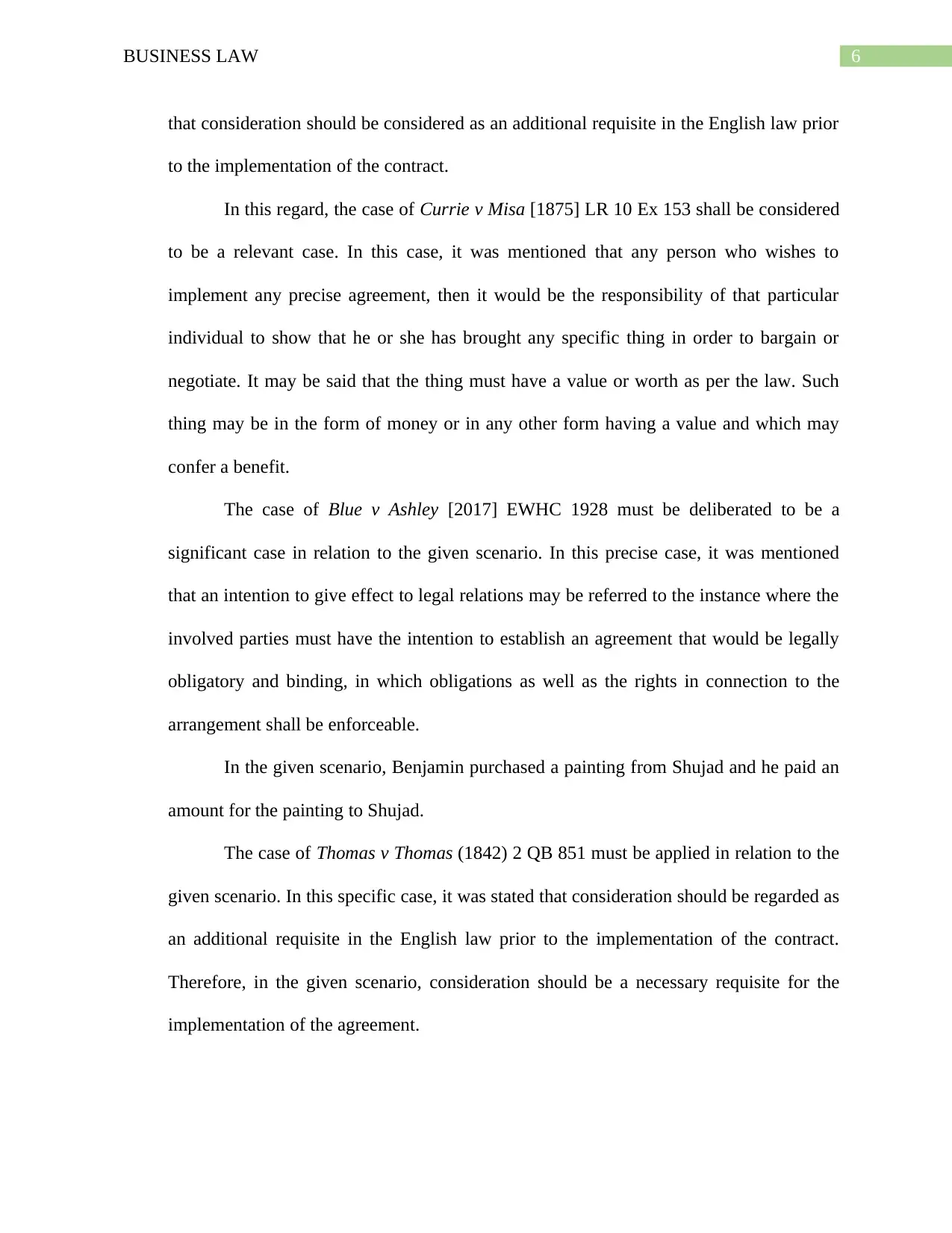
6BUSINESS LAW
that consideration should be considered as an additional requisite in the English law prior
to the implementation of the contract.
In this regard, the case of Currie v Misa [1875] LR 10 Ex 153 shall be considered
to be a relevant case. In this case, it was mentioned that any person who wishes to
implement any precise agreement, then it would be the responsibility of that particular
individual to show that he or she has brought any specific thing in order to bargain or
negotiate. It may be said that the thing must have a value or worth as per the law. Such
thing may be in the form of money or in any other form having a value and which may
confer a benefit.
The case of Blue v Ashley [2017] EWHC 1928 must be deliberated to be a
significant case in relation to the given scenario. In this precise case, it was mentioned
that an intention to give effect to legal relations may be referred to the instance where the
involved parties must have the intention to establish an agreement that would be legally
obligatory and binding, in which obligations as well as the rights in connection to the
arrangement shall be enforceable.
In the given scenario, Benjamin purchased a painting from Shujad and he paid an
amount for the painting to Shujad.
The case of Thomas v Thomas (1842) 2 QB 851 must be applied in relation to the
given scenario. In this specific case, it was stated that consideration should be regarded as
an additional requisite in the English law prior to the implementation of the contract.
Therefore, in the given scenario, consideration should be a necessary requisite for the
implementation of the agreement.
that consideration should be considered as an additional requisite in the English law prior
to the implementation of the contract.
In this regard, the case of Currie v Misa [1875] LR 10 Ex 153 shall be considered
to be a relevant case. In this case, it was mentioned that any person who wishes to
implement any precise agreement, then it would be the responsibility of that particular
individual to show that he or she has brought any specific thing in order to bargain or
negotiate. It may be said that the thing must have a value or worth as per the law. Such
thing may be in the form of money or in any other form having a value and which may
confer a benefit.
The case of Blue v Ashley [2017] EWHC 1928 must be deliberated to be a
significant case in relation to the given scenario. In this precise case, it was mentioned
that an intention to give effect to legal relations may be referred to the instance where the
involved parties must have the intention to establish an agreement that would be legally
obligatory and binding, in which obligations as well as the rights in connection to the
arrangement shall be enforceable.
In the given scenario, Benjamin purchased a painting from Shujad and he paid an
amount for the painting to Shujad.
The case of Thomas v Thomas (1842) 2 QB 851 must be applied in relation to the
given scenario. In this specific case, it was stated that consideration should be regarded as
an additional requisite in the English law prior to the implementation of the contract.
Therefore, in the given scenario, consideration should be a necessary requisite for the
implementation of the agreement.
Paraphrase This Document
Need a fresh take? Get an instant paraphrase of this document with our AI Paraphraser
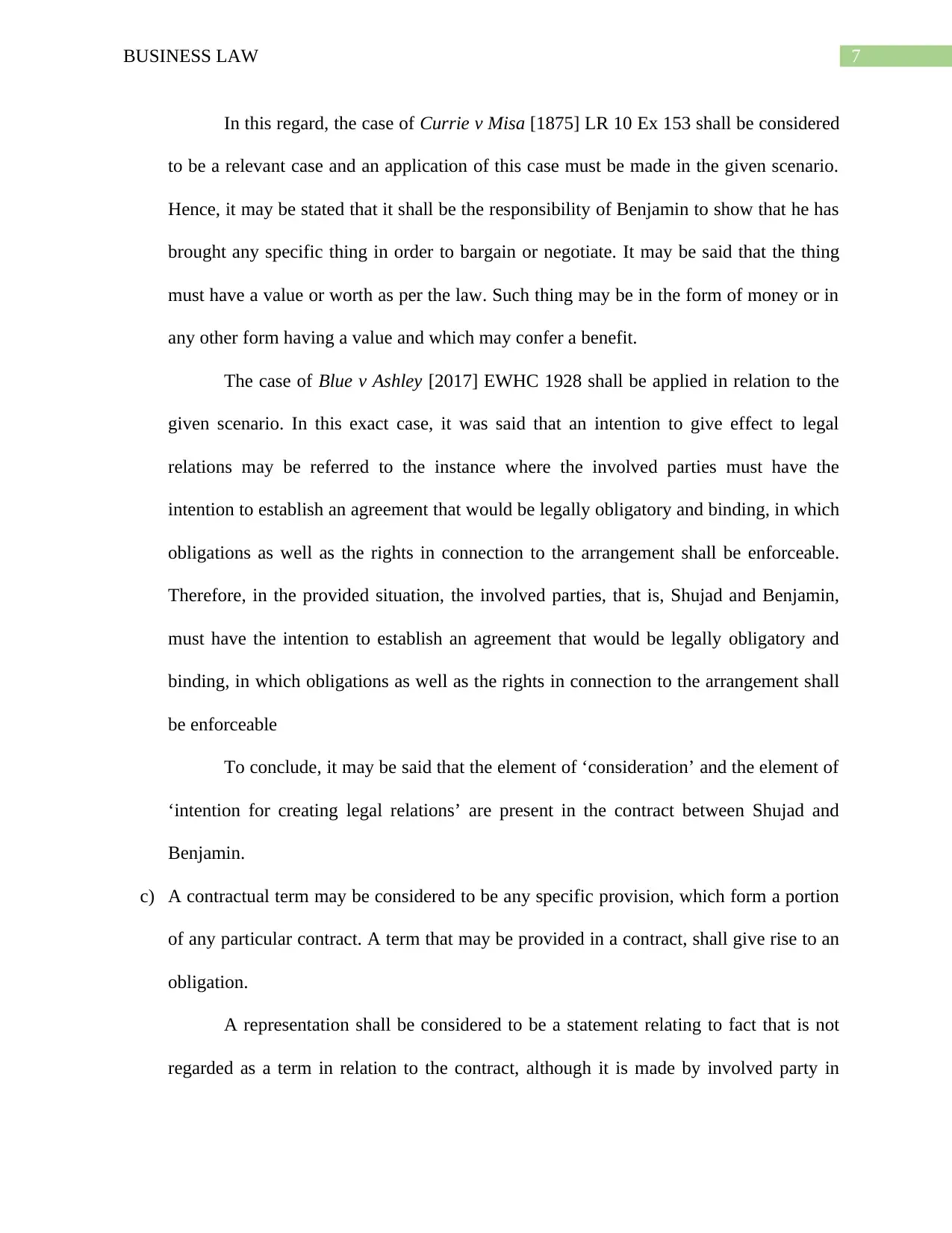
7BUSINESS LAW
In this regard, the case of Currie v Misa [1875] LR 10 Ex 153 shall be considered
to be a relevant case and an application of this case must be made in the given scenario.
Hence, it may be stated that it shall be the responsibility of Benjamin to show that he has
brought any specific thing in order to bargain or negotiate. It may be said that the thing
must have a value or worth as per the law. Such thing may be in the form of money or in
any other form having a value and which may confer a benefit.
The case of Blue v Ashley [2017] EWHC 1928 shall be applied in relation to the
given scenario. In this exact case, it was said that an intention to give effect to legal
relations may be referred to the instance where the involved parties must have the
intention to establish an agreement that would be legally obligatory and binding, in which
obligations as well as the rights in connection to the arrangement shall be enforceable.
Therefore, in the provided situation, the involved parties, that is, Shujad and Benjamin,
must have the intention to establish an agreement that would be legally obligatory and
binding, in which obligations as well as the rights in connection to the arrangement shall
be enforceable
To conclude, it may be said that the element of ‘consideration’ and the element of
‘intention for creating legal relations’ are present in the contract between Shujad and
Benjamin.
c) A contractual term may be considered to be any specific provision, which form a portion
of any particular contract. A term that may be provided in a contract, shall give rise to an
obligation.
A representation shall be considered to be a statement relating to fact that is not
regarded as a term in relation to the contract, although it is made by involved party in
In this regard, the case of Currie v Misa [1875] LR 10 Ex 153 shall be considered
to be a relevant case and an application of this case must be made in the given scenario.
Hence, it may be stated that it shall be the responsibility of Benjamin to show that he has
brought any specific thing in order to bargain or negotiate. It may be said that the thing
must have a value or worth as per the law. Such thing may be in the form of money or in
any other form having a value and which may confer a benefit.
The case of Blue v Ashley [2017] EWHC 1928 shall be applied in relation to the
given scenario. In this exact case, it was said that an intention to give effect to legal
relations may be referred to the instance where the involved parties must have the
intention to establish an agreement that would be legally obligatory and binding, in which
obligations as well as the rights in connection to the arrangement shall be enforceable.
Therefore, in the provided situation, the involved parties, that is, Shujad and Benjamin,
must have the intention to establish an agreement that would be legally obligatory and
binding, in which obligations as well as the rights in connection to the arrangement shall
be enforceable
To conclude, it may be said that the element of ‘consideration’ and the element of
‘intention for creating legal relations’ are present in the contract between Shujad and
Benjamin.
c) A contractual term may be considered to be any specific provision, which form a portion
of any particular contract. A term that may be provided in a contract, shall give rise to an
obligation.
A representation shall be considered to be a statement relating to fact that is not
regarded as a term in relation to the contract, although it is made by involved party in
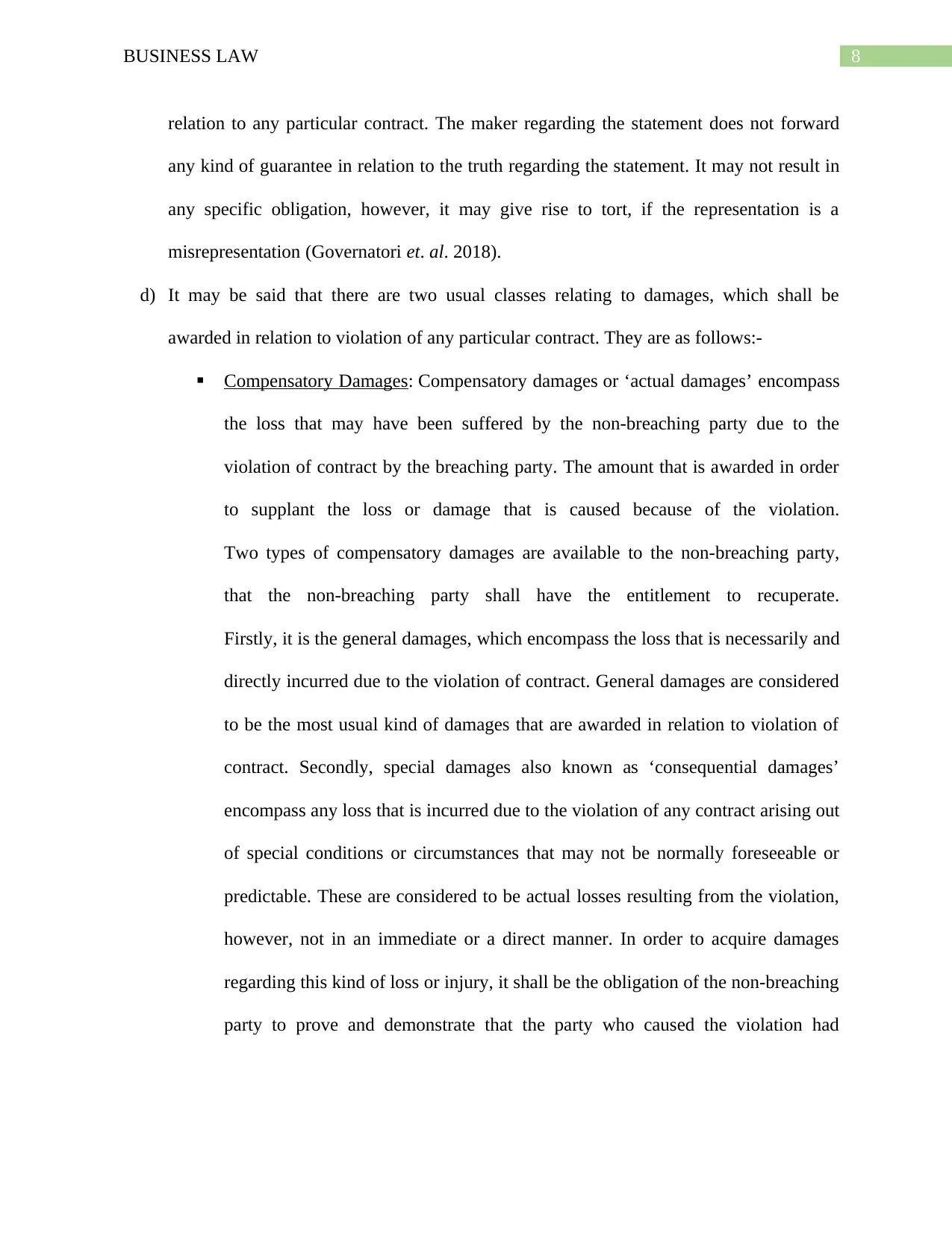
8BUSINESS LAW
relation to any particular contract. The maker regarding the statement does not forward
any kind of guarantee in relation to the truth regarding the statement. It may not result in
any specific obligation, however, it may give rise to tort, if the representation is a
misrepresentation (Governatori et. al. 2018).
d) It may be said that there are two usual classes relating to damages, which shall be
awarded in relation to violation of any particular contract. They are as follows:-
Compensatory Damages: Compensatory damages or ‘actual damages’ encompass
the loss that may have been suffered by the non-breaching party due to the
violation of contract by the breaching party. The amount that is awarded in order
to supplant the loss or damage that is caused because of the violation.
Two types of compensatory damages are available to the non-breaching party,
that the non-breaching party shall have the entitlement to recuperate.
Firstly, it is the general damages, which encompass the loss that is necessarily and
directly incurred due to the violation of contract. General damages are considered
to be the most usual kind of damages that are awarded in relation to violation of
contract. Secondly, special damages also known as ‘consequential damages’
encompass any loss that is incurred due to the violation of any contract arising out
of special conditions or circumstances that may not be normally foreseeable or
predictable. These are considered to be actual losses resulting from the violation,
however, not in an immediate or a direct manner. In order to acquire damages
regarding this kind of loss or injury, it shall be the obligation of the non-breaching
party to prove and demonstrate that the party who caused the violation had
relation to any particular contract. The maker regarding the statement does not forward
any kind of guarantee in relation to the truth regarding the statement. It may not result in
any specific obligation, however, it may give rise to tort, if the representation is a
misrepresentation (Governatori et. al. 2018).
d) It may be said that there are two usual classes relating to damages, which shall be
awarded in relation to violation of any particular contract. They are as follows:-
Compensatory Damages: Compensatory damages or ‘actual damages’ encompass
the loss that may have been suffered by the non-breaching party due to the
violation of contract by the breaching party. The amount that is awarded in order
to supplant the loss or damage that is caused because of the violation.
Two types of compensatory damages are available to the non-breaching party,
that the non-breaching party shall have the entitlement to recuperate.
Firstly, it is the general damages, which encompass the loss that is necessarily and
directly incurred due to the violation of contract. General damages are considered
to be the most usual kind of damages that are awarded in relation to violation of
contract. Secondly, special damages also known as ‘consequential damages’
encompass any loss that is incurred due to the violation of any contract arising out
of special conditions or circumstances that may not be normally foreseeable or
predictable. These are considered to be actual losses resulting from the violation,
however, not in an immediate or a direct manner. In order to acquire damages
regarding this kind of loss or injury, it shall be the obligation of the non-breaching
party to prove and demonstrate that the party who caused the violation had
⊘ This is a preview!⊘
Do you want full access?
Subscribe today to unlock all pages.

Trusted by 1+ million students worldwide
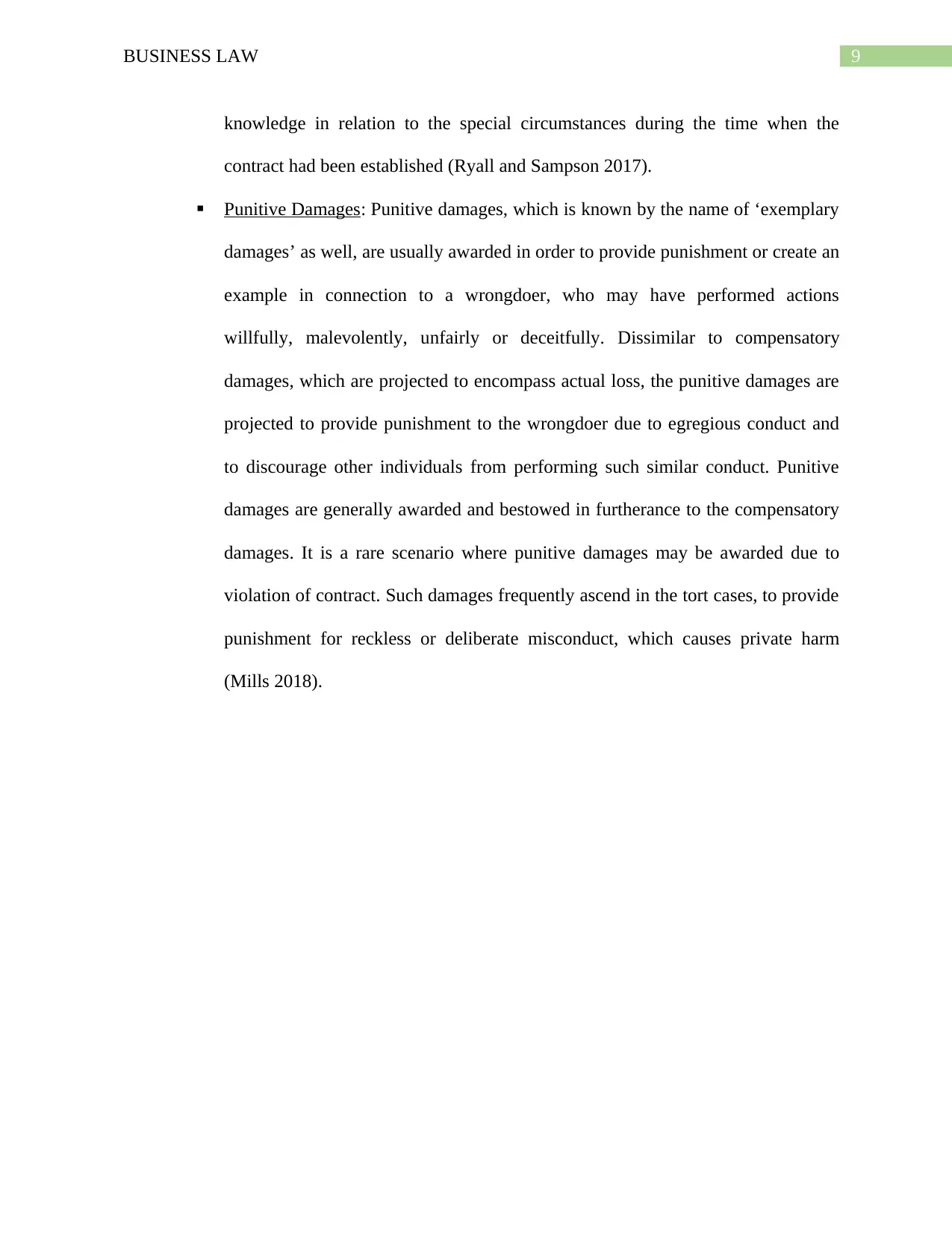
9BUSINESS LAW
knowledge in relation to the special circumstances during the time when the
contract had been established (Ryall and Sampson 2017).
Punitive Damages: Punitive damages, which is known by the name of ‘exemplary
damages’ as well, are usually awarded in order to provide punishment or create an
example in connection to a wrongdoer, who may have performed actions
willfully, malevolently, unfairly or deceitfully. Dissimilar to compensatory
damages, which are projected to encompass actual loss, the punitive damages are
projected to provide punishment to the wrongdoer due to egregious conduct and
to discourage other individuals from performing such similar conduct. Punitive
damages are generally awarded and bestowed in furtherance to the compensatory
damages. It is a rare scenario where punitive damages may be awarded due to
violation of contract. Such damages frequently ascend in the tort cases, to provide
punishment for reckless or deliberate misconduct, which causes private harm
(Mills 2018).
knowledge in relation to the special circumstances during the time when the
contract had been established (Ryall and Sampson 2017).
Punitive Damages: Punitive damages, which is known by the name of ‘exemplary
damages’ as well, are usually awarded in order to provide punishment or create an
example in connection to a wrongdoer, who may have performed actions
willfully, malevolently, unfairly or deceitfully. Dissimilar to compensatory
damages, which are projected to encompass actual loss, the punitive damages are
projected to provide punishment to the wrongdoer due to egregious conduct and
to discourage other individuals from performing such similar conduct. Punitive
damages are generally awarded and bestowed in furtherance to the compensatory
damages. It is a rare scenario where punitive damages may be awarded due to
violation of contract. Such damages frequently ascend in the tort cases, to provide
punishment for reckless or deliberate misconduct, which causes private harm
(Mills 2018).
Paraphrase This Document
Need a fresh take? Get an instant paraphrase of this document with our AI Paraphraser

10BUSINESS LAW
References
Adam v Lindsell [1818] B & Ald 681.
Blue v Ashley [2017] EWHC 1928.
Central London Property Trust Ltd v High Trees House Ltd [1947] KB 130.
Collier v P & MJ Wright (Holdings) Ltd [2007] EWCA Civ 1329.
Currie v Misa [1875] LR 10 Ex 153.
Fisher v Bell [1961] 1 QB 394.
Goldberg, J.C., Smith, H.E. and Turner, P.G. eds., 2019. equity and law. Cambridge University
Press.
Governatori, G., Idelberger, F., Milosevic, Z., Riveret, R., Sartor, G. and Xu, X., 2018. On legal
contracts, imperative and declarative smart contracts, and blockchain systems. Artificial
Intelligence and Law, 26(4), pp.377-409.
Henthorn v Fraser [1892] 2 Ch 27.
Holwell Securities v Hughes [1974] 1 WLR 155.
Kumarage, A.M., 2016. Applicability of Conventional Contract Law Rules to Contracts Made
Online: A Critical Analysis of Rules on Offer and Acceptance.
McFarlane, B., 2019. Avoiding anarchy? Common law v Equity & Maitland v Hohfeld.
Cambridge University Press.
References
Adam v Lindsell [1818] B & Ald 681.
Blue v Ashley [2017] EWHC 1928.
Central London Property Trust Ltd v High Trees House Ltd [1947] KB 130.
Collier v P & MJ Wright (Holdings) Ltd [2007] EWCA Civ 1329.
Currie v Misa [1875] LR 10 Ex 153.
Fisher v Bell [1961] 1 QB 394.
Goldberg, J.C., Smith, H.E. and Turner, P.G. eds., 2019. equity and law. Cambridge University
Press.
Governatori, G., Idelberger, F., Milosevic, Z., Riveret, R., Sartor, G. and Xu, X., 2018. On legal
contracts, imperative and declarative smart contracts, and blockchain systems. Artificial
Intelligence and Law, 26(4), pp.377-409.
Henthorn v Fraser [1892] 2 Ch 27.
Holwell Securities v Hughes [1974] 1 WLR 155.
Kumarage, A.M., 2016. Applicability of Conventional Contract Law Rules to Contracts Made
Online: A Critical Analysis of Rules on Offer and Acceptance.
McFarlane, B., 2019. Avoiding anarchy? Common law v Equity & Maitland v Hohfeld.
Cambridge University Press.

11BUSINESS LAW
Mills, A., 2018. Recognition of Punitive Damages in the United Kingdom. Bariatti, Crespi and
Fumagalli (eds), Punitive Damages and European Private International Law (Forthcoming).
Re London & Northern Bank, ex p. Jones [1900] 1 Ch 220.
RTS Flexible Systems Limited v Molkerei Alois Müller GmbH [2010] UKSC 14.
Ryall, M.D. and Sampson, R.C., 2017. Contract structure for joint production: risk and
ambiguity under compensatory damages. Management Science, 63(4), pp.1232-1253.
Thomas v Thomas (1842) 2 QB.
Mills, A., 2018. Recognition of Punitive Damages in the United Kingdom. Bariatti, Crespi and
Fumagalli (eds), Punitive Damages and European Private International Law (Forthcoming).
Re London & Northern Bank, ex p. Jones [1900] 1 Ch 220.
RTS Flexible Systems Limited v Molkerei Alois Müller GmbH [2010] UKSC 14.
Ryall, M.D. and Sampson, R.C., 2017. Contract structure for joint production: risk and
ambiguity under compensatory damages. Management Science, 63(4), pp.1232-1253.
Thomas v Thomas (1842) 2 QB.
⊘ This is a preview!⊘
Do you want full access?
Subscribe today to unlock all pages.

Trusted by 1+ million students worldwide
1 out of 12
Related Documents
Your All-in-One AI-Powered Toolkit for Academic Success.
+13062052269
info@desklib.com
Available 24*7 on WhatsApp / Email
![[object Object]](/_next/static/media/star-bottom.7253800d.svg)
Unlock your academic potential
Copyright © 2020–2025 A2Z Services. All Rights Reserved. Developed and managed by ZUCOL.





